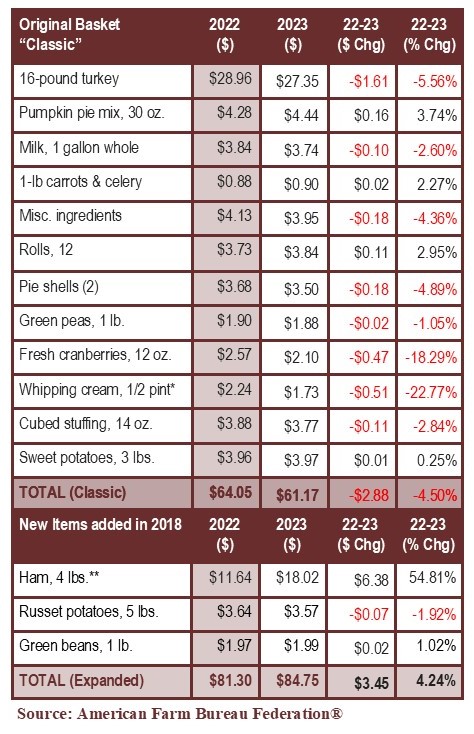The cost of a traditional thanksgiving dinner dropped 4.5% from last year. If you don't notice when you're paying your grocery checkout, it's likely because prices are still 25% higher than they were in 2019.
Farmers and ranchers only see a small portion (14.5%) of what we pay at the grocery store. The rest (85.5%) goes to the supply chain, which is still having trouble getting some items on the shelves.
Over half of bank farm and agriculture loans come from community banks. Those with more than $295 million outstanding in loans to U.S. Farming and Agricultural (as of June 30th) are listed in this week's Jumbo Rate News.
Forget About Ham, Grab Yourself a Turkey
Turkey, the centerpiece of most American Thanksgiving Dinners, increased in price by almost 50% between 2020 and 2022. We can all give thanks this year, that the price of feeding our collective families a “Traditional Thanksgiving Dinner” has finally come down, at least a bit.
2023 marks the 38th year that the American Farm Bureau Federation® (AFBF) has conducted its informal Annual Cost of Thanksgiving Dinner Survey. There have been 12 times since the survey began that the average price dropped year-over-year.
Every other year, the price has risen, which is to be expected. What was not expected was the 49.4% increase in the cost of a bird in a two year span. Yet, almost every basket item increased by double digit percentage points between 2020 and 2022. A correction was due.
Yes, the cost of feeding a family of 10 did drop 4.5% from last year, but before you get too excited, it is still up 25%, on average, from 2019. That’s according to the AFBF’s “traditional basket”, which it began surveying in 1986.
There are two asterisks in this year’s chart: one in the original basket and the other in the expanded basket. Both are due to supply issues:
* Many of the volunteer shoppers had trouble finding a half pint of whipping cream, so instead they surveyed the cost of a full pint (which was available) and divided the cost in half.
** Starting this year, bone-in-ham, which has become increasing difficult to find in retail stores, was replaced with boneless ham in the expanded menu. Boneless ham is much more expensive so the cost increase on the expanded menu chart (page 2) is not apples-to-apples from previous years.
Something we don’t pay nearly as much attention to as we probably should, is our farmers and ranchers, the people who make this, and most meals, possible for the rest of us. Only about 14.5% of what we spend at the grocery store gets back to the farm. (That’s less than $9 of this year’s classic meal cost of $61.17.)
The remaining 85.5% goes to the food supply chain that gets the finished products into stores. Let’s take a moment to thank those farmers and ranchers that make this meal possible for us every year.
God Bless you all. Have a safe and Happy Thanksgiving!
Of course we can’t forget the banks that make loans to farmers, either. Bank farm loans increased by 6.9% during the 12 months ending June 30th (from $70.9 billion to $75.7 billion. Over half of that ($47.3 billion) comes from community banks. Those with more than $295 million outstanding in loans to U.S. Farming and Agricultural (as of June 30th) can be found on page 7.
The list is similar to last year at this time, but this year we provided it in descending order by the amount of Ag loans instead of alpha by state. That’s to highlight the three community banks with over $1 billion outstanding. There was just one (5-Star Bremer Bank) last year.
Two new 5-Star community banks made the list this year as well. They are 5-Star First Citizens Bank, Mason City, IA and 5-Star Elkhorn Valley B&T, Norfolk, NE. Keep up the good work.


